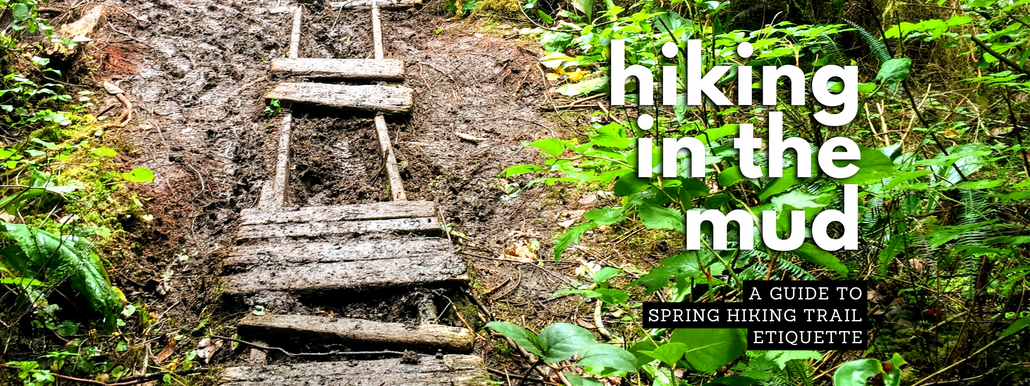Hiking in the Mud: A Guide to Spring Hiking Trail Etiquette
Posted by Kirsten on 2022 Mar 17th
Spring is in the air! The thought of spring may invite visions of flowers and sunshine to your daydreams but let’s ground ourselves for a minute as there is a more prevalent and dirty thought to attend to.
Mud.
So. Much. Mud.

As we phase out of winter, the temperature can fluctuate a lot, inciting an awkward dance between ice and mud. While spring is great for many things, it’s not an ideal time for the trails. Humans can cause significant damage to our cherished trails if caution is not heeded. Each season brings new challenges for maintaining trail systems so just as we presented Winter Hiking Trail Etiquette, let’s discuss trail etiquette during the Spring, also known as: Mud Season.
Specific to our area, many trails are “preserved” simply by continued foot traffic which ensures a clear path is easy to follow. It’s often also the case that trails are maintained and protected by volunteers. If you’ve ever been involved with a trail build - you know it is an exhausting and time consuming job. And it’s one that we all benefit from.
So, how can we each do our part to aid the trails? A little trail etiquette during mud season can go a long way.
Choose Your Trails Wisely
Some days, (or weeks), it is best to leave the trails alone. Continued use on a soft trail causes ruts, holes and unwanted widening. It’s common that maintained trails, (particularly in provincial or national parks), will be closed during the spring to avoid damage. Where you choose to hike, run or bike is key when it is particularly muddy and soft conditions are prevalent through the woods. Opting for well designed gravel, paved or boardwalk trails are a great first choice. Rocky or sandy coastal trails may also be a good plan, as well as heavily trafficked trails that have been hardened and won’t be damaged as easily. That being said, that’s not always an option which leads us to our next point.

Stick to the Trail (Pretty please!)
When you come across a muddy and wet section, it is tempting to bypass it by stepping off to the side. This, unfortunately, leads to erosion and generates further damage and issues over time. A great tip we came across is to shift your mindset from “I don’t want to get muddy”, to “I want to preserve this trail”. This means either avoiding the trail altogether or committing to staying on the trail. Let’s elaborate.
The Happy Middle
The best path forward in all seasons is to to walk down the center of the trail. Returning to the note on a mindset shift, it is sometimes the best choice to step in the mud and water to minimize damage. We aren’t talking Tough Mudder levels here, but be willing to get your shoes dirty for the betterment of the trail. For this reason, the right gear will help you step with confidence and keep your feet warm and dry. Waterproof footwear and gaiters will be the heroes of your adventure. Opting to walk on rocks, when available, is another great way to bypass the mud and protect the path. On that note, be mindful of the added risk of slipping in wet conditions. Plan to hike slower and more mindfully. Especially in the awkward stage where ice remains present as well.

Advice for Any Season
Now that we’ve told you to stick to the middle of the trail, what do you do when you meet up with another trail user? If that trail user is a wild animal, there are a variety of reactions we might suggest but for now, let’s focus on the human trail user.
Knowing who has the right of way is key. By and large, it’s a matter of being aware and being courteous as there will always be exceptions to the ‘right-of-way’ rules. With that in mind, those going downhill or faster, yield to uphill and slower outdoors people. Additionally, solo adventurers yield to groups. A single hiker is less impactful to the surrounding ecosystem than a group. The person that yields can do so by stepping off the trail and choosing their footing carefully, opting for a rock, log or other durable surface when available.
Some Trash Talk
As winter melts away, an unfortunate reality is the litter that is revealed. Let’s all do our part by carrying out exposed trail trash wherever possible. Keeping an empty bag in your daypack is an awesome habit so you are prepared to collect and carry garbage found on your journey. On that note, be sure to follow us on Facebook and Instagram for River and Trail Trash happening again in April!
In Summary
We love seeing an increasing number of people getting active outdoors but with higher traffic comes higher impact. In order to continue enjoying the trails year round, it’s important to respect the ecosystem and trail systems. There are some instances where specific rules and regulations will apply so be sure to check out any park websites or social media for trail condition updates before venturing out. On top of keeping the trails in good working order, closures may also be in place to protect nesting or hibernating animals, as well as keep you away from a known bear or moose in the area.
Now that you know how to hike in muddy conditions, don’t forget to look up sometimes to smile and say hi to other hikers and bikers enjoying and respecting the trails as well.
REFERENCES

